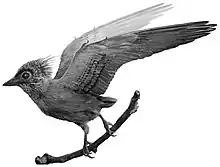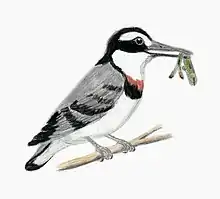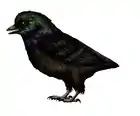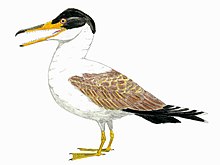| Zhongornis Temporal range: Early Cretaceous, | |
|---|---|
| Scientific classification | |
| Domain: | Eukaryota |
| Kingdom: | Animalia |
| Phylum: | Chordata |
| Clade: | Dinosauria |
| Clade: | Saurischia |
| Clade: | Theropoda |
| Clade: | Avialae |
| Genus: | †Zhongornis Gao et al., 2008 |
| Species: | †Z. haoae |
| Binomial name | |
| †Zhongornis haoae Gao et al., 2008 | |
Zhongornis (meaning "intermediate bird"[1]) is a genus of primitive avialan that lived during the Early Cretaceous. It was found in rocks of the Yixian Formation in Lingyuan City (China), and described by Gao et al. in 2008.[2]
Zhongornis has only one described species, Zhongornis haoae. The only specimen is a fossil slab and counterslab numbered D2455/6. It is in the collection of the Dalian Natural History Museum. It is a fairly complete skeleton about eight centimeters in length. Pores in the bones and unfused sutures in the skeleton indicate that the specimen was a juvenile, but the authors believe that it was developed enough to erect a new taxon on the basis of its unique morphological characters. There are feather impressions preserved on the right hand and also probable tail feathers preserved near the left foot. Zhongornis had a beaked mouth with no teeth. The tail is proportionately short, has thirteen vertebrae, and no pygostyle. The third finger has only two phalangeal bones, unlike non-avian dinosaurs and Confuciusornis, and more like Enantiornithes and more advanced avialans. These features and a cladistic analysis indicate that Zhongornis is the sister group to all pygostylia, meaning that it is intermediate between long-tailed Avialae, like Archaeopteryx, and more advanced taxa, like Confuciusornis.
Evolutionary significance
Zhongornis provides important anatomical information about the evolutionary transition from primitive basal Avialae like Archaeopteryx, which had a long bony tail and a dinosaur-like third finger, to the more advanced avialans like the Enantiornithes, which had reduced third fingers and tails fused into rigid pygostyles. Zhonghornis is the only fossil ever found that seems to be intermediate in these features. It appears to have one less bone in the third finger than Archaeopteryx, and one more than Longipteryx, suggesting that it is an intermediate between the two.[2] Zhongornis also seems to be intermediate in its tail anatomy. It has only thirteen caudal vertebrae, far less than the 22 in Archaeopteryx. None of the vertebral centra are fused, but the last four do form a continuous lateral flange, implying that this specimen had an incipient pygostyle. Previous to this fossil Sanz et al. (1992) suggested that the evolution of the pygostyle may have proceeded as the numerous vertebrae of the tail became very small and highly ankylosed.[3] Zhongornis suggests that shortening of the tail, and a large reduction in the number of vertebrae, preceded the origin of the pygostyle in the evolution of at least one bird language.
Other interpretations
After a detailed restudy, O'Connor and Sullivan suggest that this juvenile bird from the Early Cretaceous Jehol fauna of China actually possesses 20, rather than 14, tail vertebrae; further, this tail is very similar to those of Epidexipteryx (a scansoriopterygid) and Caudipteryx (an oviraptorosaur). Based on this and other features, the authors reinterpreted Zhongornis as the sister taxon of scansoriopterygids, and further suggested that this clade (Zhongornis + Scansoriopterygidae) is the sister group of Oviraptorosauria.[4] Other phylogenetic analyses, including a larger dataset, don't consider the hypothesis that Zhongornis is a scansoriopterygid, instead finding it in its traditional position as a primitive relative of pygostylians, or as a close relative of Confuciusornis.[5]
References
- ↑ Li, D.; Sulliven, C.; Zhou, Z; Zhang, Z. (2010). "Basal birds from China: a brief review." Chinese Birds, 1(2): 83-96 doi:10.5122/cbirds.2010.0002
- 1 2 Gao, Cunling; Chiappe, L.M.; Meng, Q.; O'Connor, J.K.; Wang, X.; Cheng, X.; Liu, J. (2008) "A New Basal Lineage Of Early Cretaceous Birds From China And Its Implications On The Evolution Of The Avian Tail." "Palaeontology" Vol. 51, Part 4, pp. 775-791. doi:10.1111/j.1475-4983.2008.00793.x
- ↑ Sanz, J.L., Bonaparte, J.F. (1992) A New Order of Birds (Class Aves) From the Lower Cretaceous of Spain. Bulletin of the Natural History Museum of Los Angeles, Science Series. 36, 39-49.
- ↑ O'Connor, Jingmai K; Sullivan, Corwin (January 2014). "Reinterpretation of the Early Cretaceous maniraptoran (Dinosauria: Theropoda) Zhongornis haoae as a scansoriopterygid-like non-avian, and morphological resemblances between scansoriopterygids and basal oviraptorosaurs" (PDF). Vertebrata PalAsiatica. 52 (1): 3–30.
- ↑ Cau, Andrea; Brougham, Tom; Naish, Darren (2015). "The phylogenetic affinities of the bizarre Late Cretaceous Romanian theropod Balaur bondoc(Dinosauria, Maniraptora): Dromaeosaurid or flightless bird?". PeerJ. 3: e1032. doi:10.7717/peerj.1032. PMC 4476167. PMID 26157616.


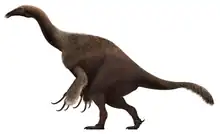
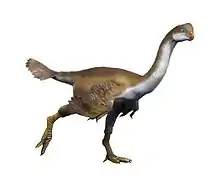
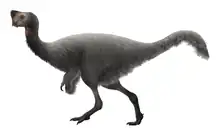
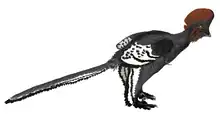


.png.webp)

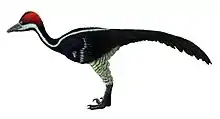
.jpg.webp)
